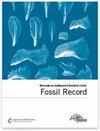Jason A. Dunlop, Ronny Rößler
下载PDF
{"title":"The youngest trigonotarbid Permotarbus schuberti n. gen., n. sp. from the Permian Petrified Forest of Chemnitz in Germany","authors":"Jason A. Dunlop, Ronny Rößler","doi":"10.1002/mmng.201300012","DOIUrl":null,"url":null,"abstract":"<p>A new trigonotarbid (Arachnida: Trigonotarbida) is described as <i>Permotarbus schuberti</i> n. gen., n. sp. from the Early Permian Petrified Forest (Rotliegend) of Chemnitz in Saxony (Germany). At ca. 290 Ma it represents the youngest record of this extinct arachnid order discovered to date. Its familial affinities are uncertain, but may lie close to the Aphantomartidae. The distribution of the trigonotarbid genera through time is summarised, together with a list of their seventy-seven fossil-yielding localities. Together they offer a broad overview of the group's fossil record, which is heavily biased towards the Moscovian Stage (ca. 307–312 Ma) of the Late Carboniferous in Europe and North America. This is due in no small part to numerous localities associated with coal mining districts, and trigonotarbids are found less frequently after this stage. While it is tempting to associate this with biological events – such as a putative ‘Carboniferous Rainforest Collapse' dating to ca. 305 Ma – it is difficult to differentiate the effects of genuine extinction patterns from artefacts caused by fewer appropriate localities in the economically less relevant latest Carboniferous and Early Permian strata. Nevertheless, trigonotarbids became extinct at some point after the Early Permian and loss of the Coal Measures forests remains one of the most likely possible causes. (© 2013 WILEY-VCH Verlag GmbH & Co. KGaA, Weinheim)</p>","PeriodicalId":55147,"journal":{"name":"Fossil Record","volume":"16 2","pages":"229-243"},"PeriodicalIF":2.1000,"publicationDate":"2013-08-05","publicationTypes":"Journal Article","fieldsOfStudy":null,"isOpenAccess":false,"openAccessPdf":"https://sci-hub-pdf.com/10.1002/mmng.201300012","citationCount":"16","resultStr":null,"platform":"Semanticscholar","paperid":null,"PeriodicalName":"Fossil Record","FirstCategoryId":"89","ListUrlMain":"https://onlinelibrary.wiley.com/doi/10.1002/mmng.201300012","RegionNum":4,"RegionCategory":"地球科学","ArticlePicture":[],"TitleCN":null,"AbstractTextCN":null,"PMCID":null,"EPubDate":"","PubModel":"","JCR":"Q3","JCRName":"Earth and Planetary Sciences","Score":null,"Total":0}
引用次数: 16
引用
批量引用
Abstract
A new trigonotarbid (Arachnida: Trigonotarbida) is described as Permotarbus schuberti n. gen., n. sp. from the Early Permian Petrified Forest (Rotliegend) of Chemnitz in Saxony (Germany). At ca. 290 Ma it represents the youngest record of this extinct arachnid order discovered to date. Its familial affinities are uncertain, but may lie close to the Aphantomartidae. The distribution of the trigonotarbid genera through time is summarised, together with a list of their seventy-seven fossil-yielding localities. Together they offer a broad overview of the group's fossil record, which is heavily biased towards the Moscovian Stage (ca. 307–312 Ma) of the Late Carboniferous in Europe and North America. This is due in no small part to numerous localities associated with coal mining districts, and trigonotarbids are found less frequently after this stage. While it is tempting to associate this with biological events – such as a putative ‘Carboniferous Rainforest Collapse' dating to ca. 305 Ma – it is difficult to differentiate the effects of genuine extinction patterns from artefacts caused by fewer appropriate localities in the economically less relevant latest Carboniferous and Early Permian strata. Nevertheless, trigonotarbids became extinct at some point after the Early Permian and loss of the Coal Measures forests remains one of the most likely possible causes. (© 2013 WILEY-VCH Verlag GmbH & Co. KGaA, Weinheim)
德国开姆尼茨二叠纪石化森林中最年轻的三角tarbus schuberti n. gen., n. sp.
报道了德国萨克森州开姆尼茨早二叠世石化林(Rotliegend)中的一种新的三角tarbida(蛛形纲:Trigonotarbida): Permotarbus schuberti n. gen., n. sp.。大约290年前,它是迄今为止发现的这种已灭绝的蛛形纲最年轻的记录。它的家族亲缘关系尚不确定,但可能接近象甲科。本文总结了三角虫属在时间上的分布,并列出了它们的77个化石产地。它们共同提供了对该群体化石记录的广泛概述,这些记录严重偏向于晚石炭世欧洲和北美的莫斯科阶段(约307-312 Ma)。这在很大程度上是由于与煤矿区有关的许多地方,在这一阶段之后,三角杉的发现频率较低。虽然人们很容易将其与生物事件联系起来——比如可以追溯到大约305万年的假定的“石炭纪雨林崩溃”——但很难区分真正的灭绝模式的影响,以及在经济上不太相关的最新石炭纪和早二叠纪地层中较少适当地点造成的人工制品。然而,三角杉在早二叠纪之后的某个时候灭绝了,煤田森林的消失仍然是最有可能的原因之一。(©2013 WILEY-VCH Verlag GmbH &KGaA公司,Weinheim)
本文章由计算机程序翻译,如有差异,请以英文原文为准。

 求助内容:
求助内容: 应助结果提醒方式:
应助结果提醒方式:


